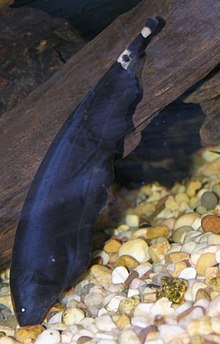电鳗目
电鳗目(学名:Gymnotiformes)为真骨骨鳔类硬骨鱼,分布于新热带界(北阿根廷至南墨西哥地区)的淡水流域[2](有部分种类会游至半咸水流域觅食),多为夜行性。电鳗目的成员透过摆动延长的臀鳍游动,可以在自身周围产生电场进行探测与沟通。部分大型物种如电鳗(Electrophorus electricus)可以运用强力的电场进行攻击或是自卫。[3]电鳗目中有许多物种为观赏鱼,包括线翎电鳗(俗称黑魔鬼)、线鳍电鳗(俗称玻璃飞刀)与圭亚那裸背电鳗(俗称虎纹飞刀)。
| 电鳗目 化石时期:
| |
|---|---|

| |
| 线翎电鳗(Apteronotus albifrons) | |
| 科学分类 | |
| 界: | 动物界 Animalia |
| 门: | 脊索动物门 Chordata |
| 纲: | 辐鳍鱼纲 Actinopteri |
| 亚纲: | 新鳍亚纲 Neopterygii |
| 下纲: | 真骨下纲 Teleostei |
| 高群: | 骨舌鱼高群 Osteoglossocephalai |
| 总群: | 鲱头鱼总群 Clupeocephala |
| 群: | 骨鲱群 Otomorpha |
| 亚群: | 骨鳔亚群 Ostariophysi |
| 派: | 耳鳔派 Otophysa |
| 总目: | 鲇形总目 Siluriphysae |
| 目: | 电鳗目 Gymnotiformes |
| 亚目 | |
描述
编辑除了电鳗之外,电鳗目的成员体型侧扁且具尖细尾部,因此常被俗称为“飞刀”(弓背鱼科的成员有时也因为身形的关系同样被称为“飞刀”)。电鳗目不具有背鳍与腹鳍,臀鳍则几乎延展至整个身体的下侧,透过摆动臀鳍游动,身体则不左右摆动。这种游动方式使得电鳗目的成员得以轻易地前行或倒退游动[4]。
尾鳍大幅退化,鳃孔小,肛门则位于头部至胸鳍位置的腹侧[5]。
电鳗目具有发电器官,由肌肉细胞特化而成,让它们具有放电的能力,少数例如线翎电鳗科其发电器官则是由神经细胞特化。放电可为持续放电或者间歇性放电,间歇性放电的波形、持续时间、振福与频率会因为种的不同而有差异,用来作为种间辨别的依据[6]。
电鳗目的成员所放出的电多半仅有数毫伏,主要用于侦查周遭环境与潜藏在底部的猎物,或者用于同种之间的沟通[7]。较大型的成员如电鳗,所发出的电流足以击晕猎物[4],新品种伏打电鳗(Electrophorus voltai)(其实是从电鳗E. electricus当中拆分出来的)可输出比一般普通电鳗发出的650伏发出更高的860伏。另一个新品种瓦氏电鳗(electroporus vari)则能发出572伏。
分类
编辑目前电鳗目共有5科34属约250种,有部分物种尚未有明确分类[8][9][10],所以实际的物种数仍然尚待明确。[11]电鳗目被认为是鲇形目的姊妹群[12][13],大约在1亿2千万年前的白垩纪时期分歧。
电鳗目为辐鳍鱼纲的其中一目,其下分2个亚目:[14][10]
电鳗目 Gymnotiformes
参考文献
编辑- ^ Froese, R. & Pauly, D. (eds.) (2007). Gymnotiformes. FishBase. Version 2007-Apr.
- ^ Berra, Tim M. Freshwater Fish Distribution. University of Chicago Press. 2008. ISBN 978-0-226-04443-9.
- ^ van der Sleen, P.; J.S. Albert (编). Field Guide to the Fishes of the Amazon, Orinoco, and Guianas. Princeton University Press. 2017: 322–345. ISBN 978-0691170749.
- ^ 4.0 4.1 Ferraris, Carl J. Paxton, J.R.; Eschmeyer, W.N. , 编. Encyclopedia of Fishes. San Diego: Academic Press. 1998: 111–112. ISBN 0-12-547665-5.
- ^ Albert, J.S. 2001. Species diversity and phylogenetic systematics of American knifefishes (Gymnotiformes, Teleostei). Misc. Publ. Mus. Zool. University of Michigan, 190:1-127.
- ^ Crampton, W.G.R. and J.S. Albert. 2006. Evolution of electric signal diversity in gymnotiform fishes. Pp. 641-725 in Communication in Fishes. F. Ladich, S.P. Collin, P. Moller & B.G Kapoor (eds.). Science Publishers Inc., Enfield, NH.
- ^ Vincent Fugère, Hernán Ortega and Rüdiger Krahe. 2010. Electrical signalling of dominance in a wild population of electric fish. Biol. Lett. 10.1098/rsbl.2010.0804
- ^ Albert, J.S., and W.G.R. Crampton. 2005. Electroreception and electrogenesis. Pp. 431-472 in The Physiology of Fishes, 3rd Edition. D.H. Evans and J.B. Claiborne (eds.). CRC Press.
- ^ Eschmeyer, W. N., & Fong, J. D. (2016). Catalog of fishes: Species by family/subfamily.
- ^ 10.0 10.1 Ferraris Jr, C.J.; C.D. de Santana; R.P. Vari. Checklist of Gymnotiformes (Osteichthyes: Ostariophysi) and catalogue of primary types. Neotrop. ichthyol. 2017, 15 (1). doi:10.1590/1982-0224-20160067.
- ^ Albert, J.S. and W.G.R. Crampton. 2005. Diversity and phylogeny of Neotropical electric fishes (Gymnotiformes). Pp. 360-409 in Electroreception. T.H. Bullock, C.D. Hopkins, A.N. Popper, and R.R. Fay (eds.). Springer Handbook of Auditory Research, Volume 21 (R.R. Fay and A. N. Popper, eds). Springer-Verlag, Berlin.
- ^ "Fink and Fink, 1996">FINK, S. V., & FINK, W. L. (1981). Interrelationships of the ostariophysan fishes (Teleostei). Zoological Journal of the Linnean Society, 72(4), 297-353.
- ^ "Arcila et al., 2017">Arcila, D., Ortí, G., Vari, R., Armbruster, J. W., Stiassny, M. L., Ko, K. D., ... & Betancur-R, R. (2017). Genome-wide interrogation advances resolution of recalcitrant groups in the tree of life. Nature Ecology & Evolution, 1, 0020.
- ^ Nelson, Joseph, S.; Grande, Terry C.; Wilson, Mark V. H. Fishes of the World 5. John Wiley & Sons, Inc. 2016. ISBN 978-1118342336.